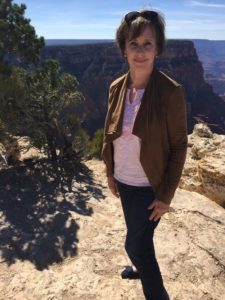 Author Name: Nancy Plain
Author Name: Nancy Plain
Latest Book Title: One Sky Above Us
- What’s the story behind the story? What inspired you to write this book?
- NANCY: Even though I’m from the East Coast, I’ve always been drawn to true tales of the West. I also love to explore the mystery of other people’s lives. The story of Chief Joseph and the Nez Perce is one of those mysteries to me. I wrote this book because I wanted to know how they lived, how they faced the Americans’ invasion of their ancestral land, and how they endured.
- If you had to pick theme songs for the main characters of your book, what would they be?
- NANCY: I’m a big fan of country music, so I’d just choose a song that puts my spirit out West: Lacy Dalton’s “The Last Wild Place.” As for my main characters, I wish I could hear them singing their own songs.
- What books are on your to-be-read pile right now?
- NANCY: It’s a tall pile. Here are a few:
- Custer Died for Your Sins, by Vine Deloria Jr.
- House Made of Dawn, by N. Scott Momaday
- Geronimo and Sitting Bull: Leaders of the Legendary West, by Bill Markley
- Sister Lumberjack, by Candace Simar.
- Bill and Candace are both good friends from Western Writers of America and outstanding writers.
- NANCY: It’s a tall pile. Here are a few:
- What scene in your book was your favorite to write?
- NANCY: There are many exciting scenes, most happening while the Nez Perce were on their 1500-mile flight toward freedom: How they crossed the treacherous rapids of the Snake River, how they braved an impossibly steep and narrow path out of Yellowstone National Park, how they fought off the U.S. Army at every turn until the last. And I loved writing scenes where the Nez Perce spoke for themselves: “I belong to the land out of which I came. The earth is my mother.”
- Do you have any quirky writing habits?
- NANCY: Well, I have to have a cup of coffee nearby, but that’s not too quirky. My “office” is my living room couch, with research books strewn all around me, and if it’s cold, I always light the fire. I revise constantly as I go along—sentence by sentence–instead of completing one draft, then working up another. If you were in the room with me, you would see me staring into space a whole lot.
- What’s next for you?
- NANCY: I’m working on more young adult nonfiction, this time, a book about the Underground Railroad. It’s a complicated and fascinating subject, with so many heroes.
- Do you have a motto, quote or philosophy you live by?
- NANCY: It’s “Nothing ventured, nothing gained.” It gives my courage a boost!
- If you could choose one thing for readers to remember after reading your book, what would it be?
- NANCY: I’d like readers to remember the bravery and perseverance of the Nez Perce people, in the face of unimaginable suffering. What it took for them to keep going. It’s a universal theme.
- Are there specific types of scenes that you struggle with?
- NANCY: What I find challenging—but also fun—are scenes in which I give the historical context embedded in a story. I really enjoy introducing kids to history, since I think that everyone loves true stories of the past if they are told in an exciting way.
- Where did you get your inspiration for your amazing characters?
- NANCY: I was always curious about the events that led up to Chief Joseph’s famous speech at the Bear Paw battlefield: “Hear me, my chiefs, I am tired; my heart is sick and sad. From where the sun now stands, I will fight no more forever.”
- What drew you to this genre in the first place?
- NANCY: The West embodies the American spirit—independence, self-sufficiency, the strength to live in a land that is both beautiful and harsh. I read Western history for both research and pleasure, and, for vacations, I look westward. In my next life, I want to be an expert horsewoman!
- An author or authors who inspire you and you look up to?
- NANCY: Many of these authors I met at WWA—Lucia St. Clair Robson, the late authors Robert Utley and Will Bagley—and more Western writer friends too numerous to mention. On the YA side, S.D. Nelson’s book Crazy Horse and Custer is a wonderful example of how history can be told. Recently, I’ve been on a World War II binge: nonfiction by Ben Macintyre, Erik Larson, the duo of Bob Drury and Tom Clavin. I learned how to write, and am constantly learning, by reading others’ books. It’s a lifelong process.
